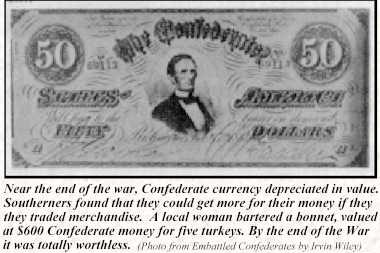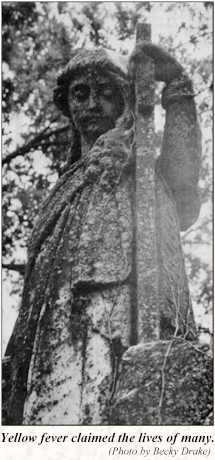A Kaleidoscope of History Reconstruction One word, DISMAL, best describes life in Raymond from December of 1858 until approximately 1880. After thirty years of successful economic growth the town suddenly began to "fall on hard times". The first real tragedy occurred December 8th, 1858 when a fire broke out in the dry goods store of Thomas Mount. The fire raged out of control and destroyed twenty-one town buildings. The damage estimate was over $200,000. Among the many stores that burned was George Harper's newspaper office, The Hinds County Gazette. Fortunately, he was able to at least save the type equipment.
Five years after the devastation caused by the "great fire of 1858", the Civil War reduced the town to a state of economic ruin. Food had become extremely scarce, people were hopelessly in debt and living conditions were very hard. Many wealthy families and plantation owners in the area lost their fortunes and turned to small scale farming in order to just survive. In 1864, one year after the Battle of Raymond another fire claimed one entire block of businesses on the north side of the town square. The once resilient Raymond had lost the strength to fight its way back. January 22, 1868 the Jackson Clarion commented "as throughout the south, property in the Raymond area declined to its lowest level since the settlement of the state and good land was practically given away - usually at the rate of twenty-three to twenty-five cents an acre - to satisfy claims." Generally speaking the term "reconstruction era" was applied to the rebuilding efforts of the south. Costly railroad lines had been destroyed by the Union troops, fences were down, valuable crops had been ruined, many newspapers had stopped printing, and, worse yet, Confederate money was worthless! The Hinds County Gazette, a target for Yankee destruction, was totally destroyed during the Battle of Raymond... "all its type, fixtures, and files were destroyed on the day General Grant's army entered Raymond." (Gazette, October 7th, 1865). Reconstruction was not an easy process and for Raymond it certainly meant an intense time of struggle! However, as mentioned in the History of Raymond by Beth Ferguson, "dismal as the decade was for Raymond the town did have one advantage over many other southern towns. Raymond was not burned." This accelerated the town's ability to recover from the ravages of war. Businesses emerged, farming was resumed and the economy began to make a gradual comeback. In spite of the reconstruction period and the hard years that Raymond experienced, there were a few "bright spots". Raymond did not completely lose its status as a county seat. Cooper's Wells remained a fashionable summer resort, being known as the "Saratoga of the South". In 1884 the property was bought by Mr. Spengler - from Vicksburg - and during his ownership the popular resort accommodated thousands of guests per season. In 1891 a History of Raymond (author unknown) described Raymond as "having good schools, good society, good water, and the ministers look after the spiritual affairs of the people. The business men are spirited, enterprising and progressive."
Shortly before the turn of the century, one last threat was made toward the lives and safety of the Raymond citizens. This time the threat was not fire - nor war - but the dreaded epidemic, yellow fever! Raymond, as well as all of Mississippi, had suffered thru one outbreak of yellow fever in 1878. Almost twenty years later, at the turn of the century, the fever, began to once again claim the lives of unsuspecting victims. There was total bafflement as to the cause of the fever and "how it was spread". Some said that it was transmitted by the moistness in the night air while others claimed that it was carried by the wind. The myths were endless. At the time yellow fever was definitely a dreaded disease. The basic symptoms at the onset were: a sudden high fever, headache and a slow pulse rate. As a patient approached death the skin would turn a dull shade of "yellow". During the "epidemic of 1897", the town passed an ordinance saying... "that a quarantine be declared against Ocean Springs, New Orleans and all other places infected with yellow fever - and that any and all persons from an infected district are prohibited from stopping in town. Be it further ordained that if any person or persons from an infected district shall violate this quarantine they will be fined a sum not exceeding $50.00." One year later another ordinance was passed... "any person harboring or concealing any person from an infected place - or who has been exposed to yellow fever - will be fined no less than $50.00 and no more than $100.00." In spite of all the attempts toward preventing the disease, Raymond, as well as Bolton, Lebanon, Dry Grove, Palestine, Edwards and Utica lost many lives to the fever. In 1900 a Cuban doctor, Jesse Lazear, allowed himself to be bitten by a mosquito which had previously bitten a yellow fever patient. The doctor caught the disease and died, but the world finally knew the real secret of how the fever was spread. Raymond's brief seventy years of existence in the nineteenth century had not been easy. The men, the women the churches and the town itself - with The Gazette as its spokesman - fought hard to maintain progress and uphold ideals. As the old saying goes "in order to have a future -one must first have a past." Raymond's past witnessed happy and prosperous times as well as tragic and dismal times. But, the citizens never lost hope! The turn of the century held the promise of exciting times and even further growth. © 1998-2005, all rights reserved |

